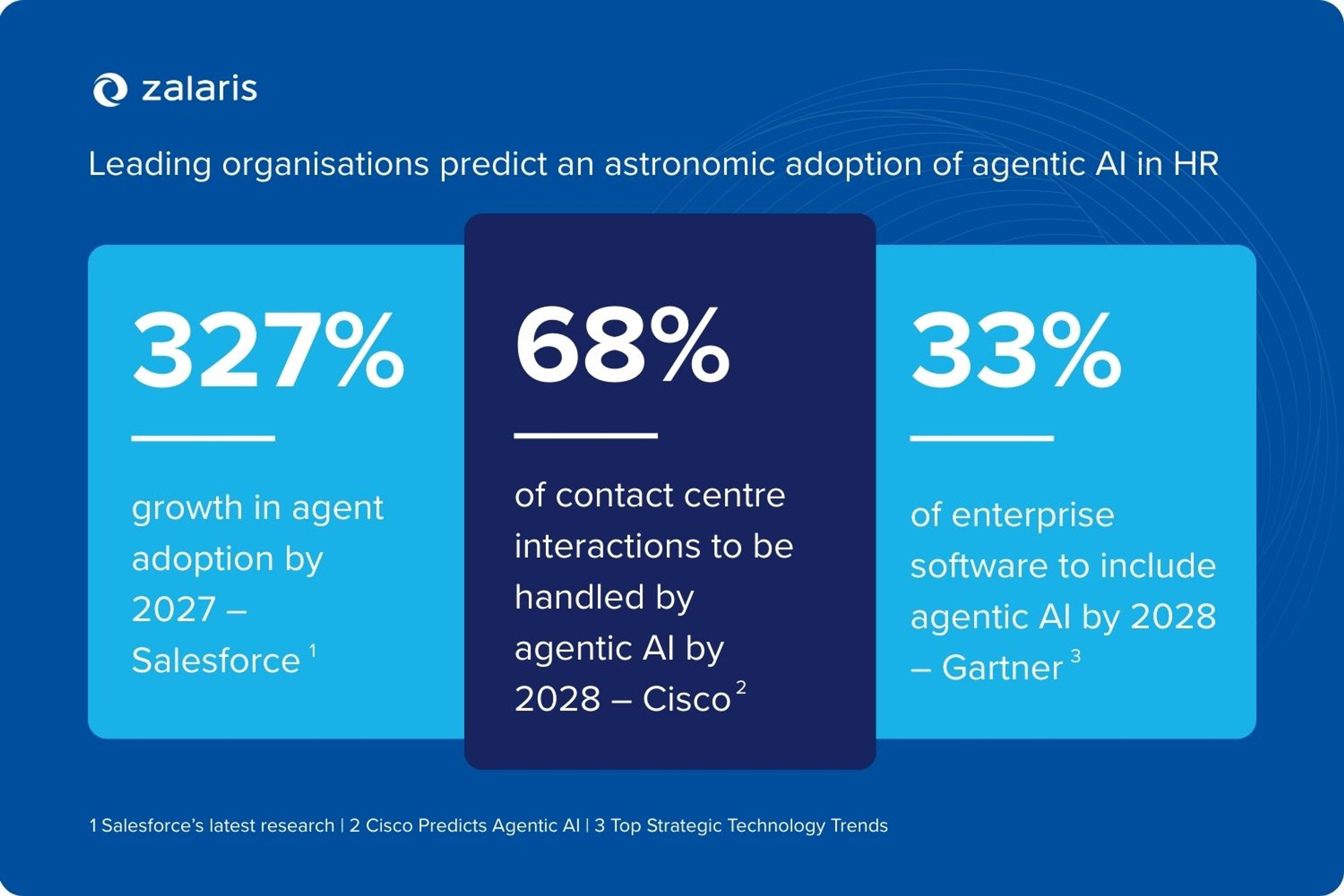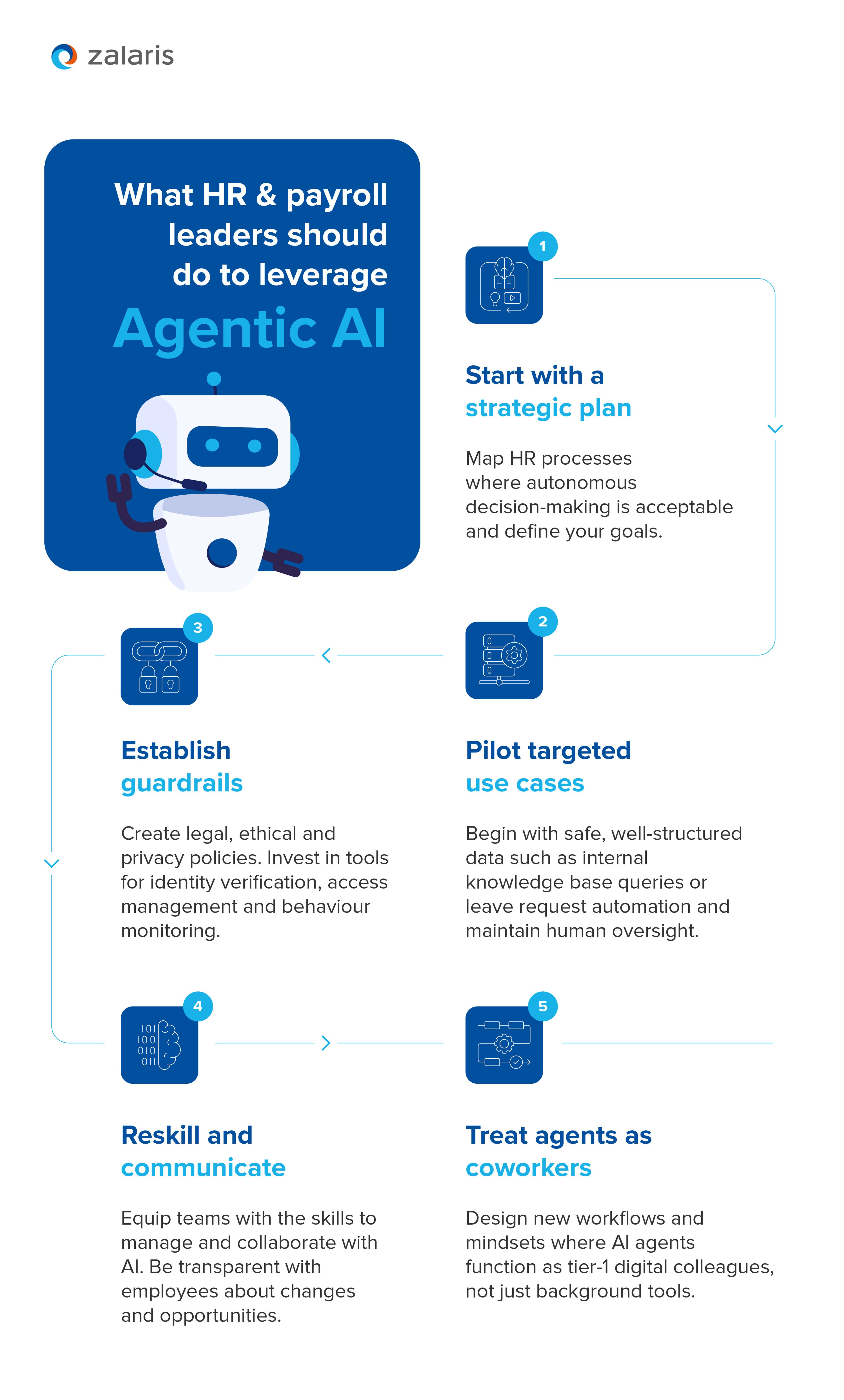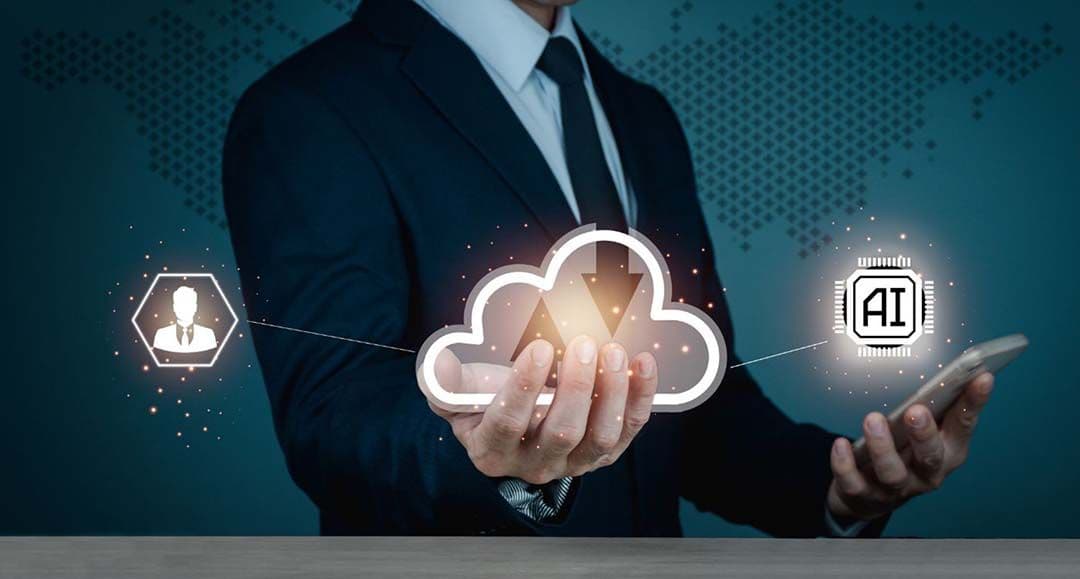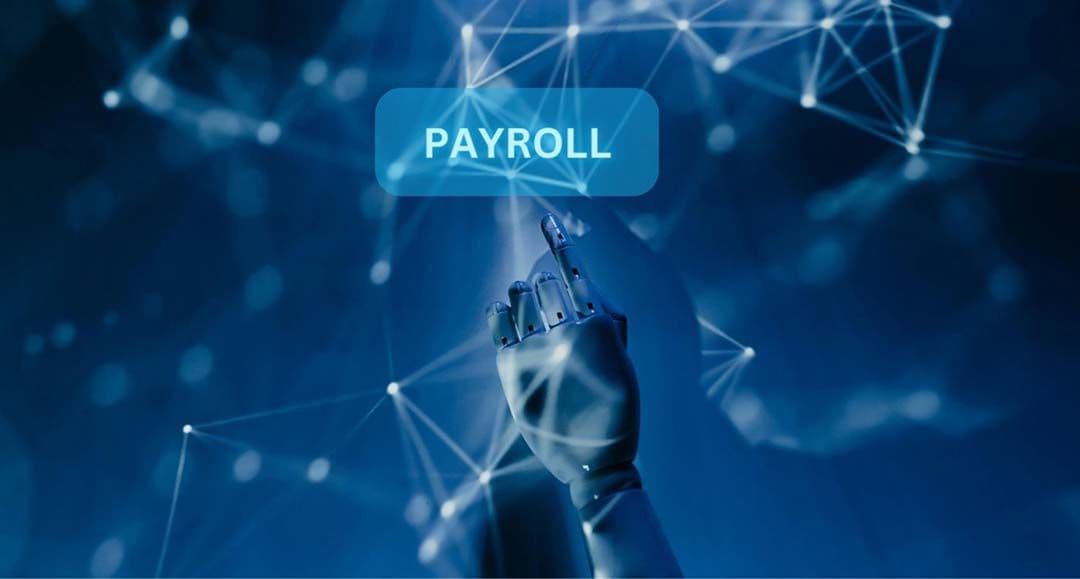Understanding agentic AI: A future-ready guide for HR leaders
The next evolution of AI in HR is already unfolding. With LLM models like SAP Joule already being integrated into many HR functions like recruitment and Core HR, agentic AI is poised to reshape how HR and Payroll teams operate.
Liam Clark

Agentic AI refers to goal-driven software entities that combine memory, planning, sensing, tooling and guardrails to achieve specific objectives. Unlike traditional automation, which executes single, repetitive tasks, or generative AI, which responds to human prompts, agentic AI systems are capable of autonomous decision-making and multi-step task execution. They can act proactively, rather than just react.
For HR and payroll leaders, this shift promises to turbo‑charge efficiency, improve decision‑making and reshape how we design work. But it also raises new questions about ethics, governance and workforce readiness.
Gartner has identified agentic AI as one of the top strategic technological trends in 2025. This article explores the benefits, use-cases and challenges of agentic AI in HR. This is a complete guide to enable your organisation to become an early adopter.
What is agentic AI - and why should HR care?
Agentic AI is a class of AI systems that combine memory, reasoning, planning and tool‑use to pursue a goal autonomously. Research from Mercer indicates that 47% of leaders using generative AI in their organisation plan to introduce Agentic AI by 2027.
Unlike traditional bots that perform a single programmed task, or generative‑AI assistants that respond to prompts, agentic AI has agency: it can break down complex objectives into sub‑tasks, decide how to accomplish them and execute actions with minimal human intervention. Unlike a chatbot, AI agents act more like a digital coworker, capable of handling tasks independently.
HR and Payroll teams currently administer many multi-step workflows such as processing payslips, answering employee queries and updating records. Agentic AI can handle routine processes as well as compile pending tasks and address them. It can analyse a broad range of employee data and conducting research - providing strategic insights for HR teams. Unlike siloed bots, agentic AI systems are capable of learning and adapting over time.

Image sources: 1.Salesforce, 2.Cisco and 3.Gartner
Benefits of agentic AI for HR and payroll
1. Efficiency and performance gains
Agentic AI introduces a digital labour force that plans and acts autonomously. As agentic AI systems mature, the performance gains could be significant. In HR, this translates to complete automation of routine tasks such as time-off approvals, payroll adjustments and benefits processing. Agentic AI systems can provide end-to-end execution, not just assistance.
Agentic AI gives HR and Payroll systems new levels of agency and offers significant opportunities for performance gains that will increase as the technology matures. Agentic AI systems can reduce time to action and enable teams to scale new initiatives rapidly. In payroll, an AI agent could handle end‑to‑end tasks from capturing time‑and‑attendance data to calculating deductions and issuing payslips, freeing staff to focus on more strategic work.

2. Better decision-making
Today’s HR analysts often spend days compiling spreadsheets before making decisions. Agentic AI can rapidly process and interpret complex workforce data and strengthen data-driven decisions in key areas like recruitment, compensation and performance management.
Agentic AI systems will change the future of decision‑making: they can quickly analyse complex datasets, identify patterns and act with minimal supervision. For example, an AI agent might forecast workforce attrition, recommend retention programmes and initiate follow‑up actions such as scheduling meetings or conducting surveys.
3. Upskilling and productivity
Agentic AI has the potential to upskill human workers, enabling them to manage complex processes using natural language rather than mastering tools. The rise of AI-human collaboration, where human employees will evolve into ‘strategic orchestrators’: Individuals who define goals, adjust parameters, and monitor progress rather than executing each step manually.
With agentic AI taking on technical routine tasks, the scope of HR roles will broaden, focusing on high-level initiatives such as workforce planning, talent strategy, employer branding and engagement, diversity, equity and inclusion (DEI) initiatives, and change management.
Working with AI agents will expose HR executives to new decision patterns and strategic perspectives, reinforcing upskilling through immersion. This collaboration exemplifies how agentic AI operates by enabling AI agents to act independently across multiple AI agents, process data from diverse data sources, and tackle complex challenges with minimal human intervention.
Cross-functional integration and connecting siloed systems
One of the most valuable traits of agentic AI is its ability to operate across fragmented systems without needing constant human handoffs. In the HR and payroll context, this means agents can retrieve data from HRM platforms, take actions in payroll engines, and trigger workflows in learning or compliance tools - all within a single interaction.
The World Economic Forum notes that Agentic AI can reduce administrative tasks, speeds up response times, and allows for more holistic decision-making. For example, an AI agent might recognise that a payroll discrepancy is related to a change in benefits, trace the issue across systems, and suggest corrections in real time.
Rather than layering yet another tool onto complex environments, agentic AI acts as a connective layer that makes the ecosystem more operational, responsive, and less dependent on manual intervention.
Use cases and early implementations of agentic AI in HR
Recruitment and talent matching
Agentic AI is already helping HR teams streamline recruitment by reducing repetitive manual work. Intelligent agents can review large volumes of CVs, shortlist candidates based on tailored criteria, and suggest improvements to job descriptions using historical hiring outcomes. These agents leverage large language models (LLMs) and natural language processing to analyse vast amounts of data efficiently. They can also coordinate interviews, track candidate experience data, and send follow-ups, giving recruiters more time to focus on assessing fit and culture.
Advanced implementations involve multiple AI agents operating simultaneously in multi-agent systems. One may be responsible for sourcing, another for ranking candidates, and a third for benchmarking offers. This type of collaboration reduces time to hire, increases process consistency, and supports more inclusive hiring practices by relying on transparent, criteria-based decisions. By integrating with existing enterprise systems and external tools, these agentic AI systems can handle complex workflows and execute tasks autonomously, boosting HR capabilities and streamlining recruitment processes.
Employee services and payroll support
Employees frequently engage with HR regarding queries about payslips, leave entitlements, benefits, or local tax deductions. AI agents are increasingly being deployed to handle these common questions autonomously, without the need for human intervention. These agents resolve many requests instantly and escalate only those requiring further review. This not only enhances the employee experience but also alleviates pressure on HR and payroll support teams.
More advanced agentic artificial intelligence systems can monitor for anomalies in payroll data, such as timesheet discrepancies or eligibility issues, alerting administrators before problems escalate. Some AI agents can even provide proactive updates to employees, such as notifying them of changes in tax legislation or upcoming benefits enrolment deadlines. This shift to real-time, always-on support marks a significant evolution in service delivery and boosts efficient operations within HR functions.

Internal mobility and workforce development
One of the most promising areas for agentic AI in HR is supporting internal career growth. AI agents can continuously analyse employees’ skills, learning records, performance data, and project contributions to identify potential matches with internal roles. This ensures that talent mobility is based on capability and potential, not just manager awareness or tenure.
Agents can also recommend upskilling paths by highlighting learning content relevant to future opportunities. In some cases, they may automatically initiate enrolment into learning programmes or suggest mentors. Once an internal move is confirmed, they can trigger relevant updates to HR and payroll systems. This kind of proactive support ensures better utilisation of internal talent, increases transparency, and helps employees feel more engaged in their development.
Strategic workforce planning
Agentic AI has the potential to significantly improve how organisations approach workforce planning. Instead of generating periodic reports, AI agents can continuously monitor workforce data and model different future scenarios. For example, an agent could assess the impact of upcoming retirements on skill availability, or model how a change in operating costs would affect team size.
These insights can be delivered in real time to decision-makers, helping them test various options before making staffing or structural changes. By integrating with payroll and finance systems, agents can provide a clearer picture of budget impact. This enables faster, more informed decisions that balance financial discipline with talent needs, while reducing the reliance on manual spreadsheet modelling or slow approval chains.
Risks and governance: What HR must plan for in the era of agentic AI systems
Decision transparency and accountability
When agents take independent action, it becomes harder to see how decisions are made. This can be especially problematic in HR or payroll, where decisions affect people's lives and require compliance with strict policies. Organisations must ensure that agentic systems provide a full audit trail. Logs should capture what decision was made, why it was made, and whether any human input was involved.
To avoid risk, teams should define which tasks agents can handle without approvals and which tasks need a human checkpoint. Dashboards that display agent performance, decision logic, and exceptions can support transparency. Leaders should also establish escalation processes so that any questionable decision can be reviewed and, if necessary, reversed. As agentic AI becomes more common, accountability needs to be baked into the process design, not applied as an afterthought.
Bias and fairness in automated decisions
AI agents are only as fair as the data they learn from. In HR, historical data may reflect unconscious bias or outdated norms. If agents are not audited regularly, they may unintentionally perpetuate inequalities in how they assess candidates, allocate performance scores, or suggest salary bands. For example, if an organisation consistently rejects female candidates who are new mothers, AI agents may replicate the same practice.
To reduce this risk, organisations must use diverse training data and regularly test models for outcomes across different demographic groups. Fairness audits should be scheduled just like compliance checks. Tools that provide clear explanations of why a decision was made can also build trust and support responsible review. HR leaders must ensure that AI supports, not undermines, goals around equity and inclusion.
Data security and system exposure
Agentic AI systems rely on broad access to data and applications. This makes them powerful, but also introduces security concerns. If an agent has too much access or is misconfigured, it could expose sensitive HR or payroll data or make unauthorised changes across systems.
Best practice involves treating each agent like a user. Access should be role-based and time-bound. Just as with human employees, agents should only have permissions that are necessary for their tasks. Additionally, organisations must protect against prompt injection attacks, where external inputs trick agents into harmful actions. IT and HR security teams should work together to monitor, limit and review agent activity on a regular basis.
Maintaining trust and engagement
The more decisions agents make, the more important it is to maintain employee trust. People need to understand when they are dealing with an AI agent, what the agent is doing, and how they can challenge or override it. If these boundaries are not clear, employees may become frustrated or anxious - especially if something goes wrong.
To build trust, organisations should be transparent about where AI models are used and give employees the chance to provide feedback. Internal communications should highlight how AI supports, not replaces, human judgement. Training managers and support staff to explain AI decisions and handle escalations will also help. In sensitive areas like performance management or pay, maintaining human oversight remains essential.

Embracing a human-centric future with AI agents
Agentic AI has the potential to transform HR and payroll – not just by improving efficiency, but by enabling new strategies and operating models. But to realise these benefits, organisations must balance innovation with ethical governance and people-first design.
Zalaris supports forward-thinking organisations across the globe with integrated HR and payroll solutions that are built for the future of work. Our platform, Zalaris PeopleHub, incorporates AI enhancements that simplify complex processes, reduce manual workload, and elevate your HR function’s strategic impact.
With deep expertise in managed services and SAP consulting, local compliance, and digital transformation, Zalaris helps your teams unlock the full potential of AI in a secure, people-first way. Get in touch with our experts to kick-start your HR transformation journey.
Frequently Asked Question (FAQ)
1. How does agentic AI differ from traditional HR automation?
Traditional HR automation focuses on executing specific, pre-programmed tasks such as issuing payslips or routing approvals within legacy systems. In contrast, agentic AI is an advanced form of artificial intelligence systems that combine reasoning, memory, planning, and natural language understanding to independently execute complex HR workflows and business processes with minimal human intervention. This enables agentic AI models to act as autonomous AI powered agents across multiple HR software systems, delivering greater efficiency, smarter decision-making, and the ability to handle complex tasks.
2. What are the best pilot use cases for agentic AI in HR?
Safe and effective pilot areas for integrating agentic AI include managing high-volume, low-risk tasks such as responding to customer service inquiries, processing leave requests, and updating employee records. These applications allow HR teams to streamline software development and operations, improve employee interactions, and demonstrate measurable benefits from agentic AI adoption early on.
3. Will agentic AI replace HR professionals?
Agentic AI is designed to enhance, not replace, human agents in HR. By automating repetitive and routine tasks, agentic AI empowers HR teams to focus on strategic priorities like talent development, workforce planning, and employee engagement. Acting as autonomous agents or digital coworkers, agentic AI systems improve productivity while supporting human decision-making and continuous learning.
4. Is agentic AI compliant with GDPR and local labour regulations?
Compliance with GDPR and local labour laws is essential when implementing agentic AI in HR. Organisations must ensure that agentic AI systems securely process and protect sensitive patient data and other personal information, maintain audit trails, and adhere to privacy regulations. Trusted platforms like Zalaris PeopleHub integrate robust compliance frameworks to enable secure and lawful use of agentic AI in HR environments.

Liam Clark
HCM Consultant
Liam is an HCM Consultant of Zalaris UK&I, with a technical and functional background of SAP Products. His current focus is on SuccessFactors Employee Central and Recruitment Modules. Before joining Zalaris at the start of 2021, he worked as a SAP HCM and Payroll Specialist within the UK Public Sector.

